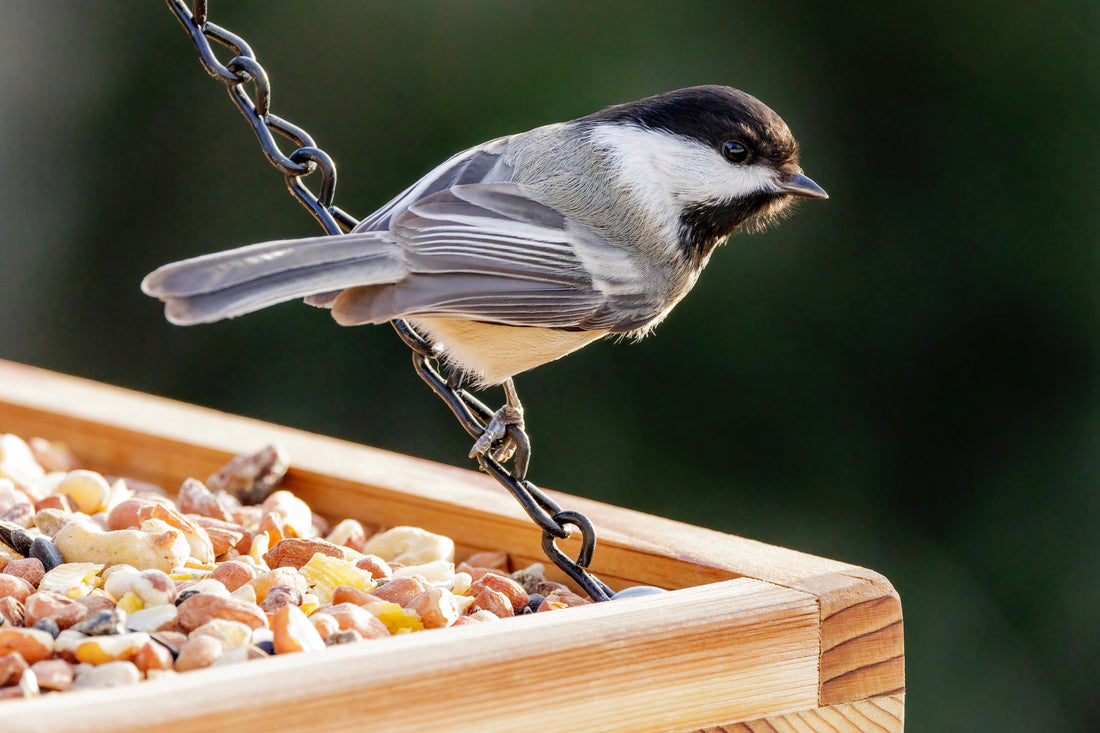
The Busy Life of the Chickadee
Share
Have you seen any chickadees in your backyard lately?
They’re known for their cute good looks, distinctive markings, and the chick-a-dee-dee-dee call they make.
This tiny bird seems to have a big place in people’s hearts.
By Jill Bromley & Casey Truffa

A Black-capped Chickadee on a feeder filled with Peanut Kernels
There is something joyful in the way a chickadee flies from tree to tree and often performs acrobatics on branches and feeders. They are endlessly curious and never stay in the same place for very long. Just like bees, they always seem to be busy. The black-capped chickadee is the official bird of the state of Massachusetts and Maine, demonstrating just how much the chickadee is loved. Maybe it's popularity is derived from the admirable characteristics it displays: being hardworking, curious, busy, sociable, fun, and playful - all at the same time. Chickadees are endlessly fascinating and endearing little birds.
If you’d like to find out more about the charming chickadee and how to attract them to your backyard, please read on.
Identifying Chickadees
North America is home to seven distinct species of chickadees, with unique colors and looks, but they share a few common characteristics.
 A Chestnut-backed Chickadee - found on the West-Coast of North America
A Chestnut-backed Chickadee - found on the West-Coast of North America
Chickadees are smaller than sparrows but with large heads relative to their body size. Being gifted in the cranium causes them to be regularly mistaken for fluffy baby birds. The crown of the head and the throat are darker than the rest of the body, and they have longish tails and short bills. For instance, the black-capped chickadee has a distinctive black cap and throat marking. All chickadees like to be in small flocks and prefer wooded or shrubby habitats. Read more about the different types of Chickadees in our article, "The 7 Species of Chickadees."
What Do Chickadees Eat?
Chickadees are enchanting little explorers, always flitting about in search of tasty treasures. These spirited birds thrive on a diet rich in seeds, nuts, insects, berries and other high-energy goodies that fuel their playful antics. Choosing the right bird seed for Chickadees is a sure way to attract them to your yard. In your backyard feeders, they’ll hope to find:
★ Sunflower Seeds: Both black oil and striped sunflower are ideal bird seeds that are irresistible to Chickadees, providing protein and healthy fats.

★ Peanuts: Rich in energy, peanuts are a staple in a Chickadee’s diet.

★ Sunflower Hearts: These shelled seeds are easy for Chickadees to eat and provide essential nutrients.

★ Tree Nuts: Assorted nuts offer a nutritious and satisfying treat for these birds.

Picture a tiny adventurer, flapping from branch to branch for sunflower seeds, protein-packed peanuts, and an array of tasty morsels. With their knack for foraging, chickadees not only enjoy their meals but also stash away treats for colder days. So, the next time you spot one, remember it’s on a mission to gather the perfect mix to keep its busy life buzzing!
Benefits of Using the Right Bird Seed
- Chickadees Can Attract Other Wild Birds: Chickadees are the charismatic leaders of the bird community. Other small birds, such as nuthatches, finches, and redpolls, seem to be aware of the chickadees intelligence. They will observe where chickadees feed and keep an ear for their distinct call. Wild bird enthusiasts know - to attract a wide variety of wild birds - start with chickadees. When you offer chickadees their favorite foods, your backyard will transform into a vibrant bird watching paradise in no time.
- Supports Bird Health: Nutrient-rich seed mixes made from premium, clean ingredients guarantee that Chickadees get the essential nourishment they require. By offering fresh seeds free from fillers and debris, you support their vitality and overall well-being.
- Creates a Thriving Ecosystem: Feeding Chickadees is a wonderful way to support these charming little birds while also enriching your local ecosystem. Their presence can draw in various other species, fostering greater biodiversity right in your own backyard.
Setting Up the Ideal Chickadee Environment
Chickadees prefer feeders that are easy to perch on, such as tube feeders or hopper feeders, but will come willingly to nearly all types. Hanging feeders are ideal for chickadees as they can perch sideways and even upside down to feed.
 A Black-capped Chickadee perched on a suet feeder upside-down
A Black-capped Chickadee perched on a suet feeder upside-down
The chickadees preferred natural habitat is among trees such as willow, alder, and birch. Having these trees in your garden or nearby will help to attract chickadees and maybe encourage them to nest in your backyard too. As long as you position your feeder in a quiet sheltered spot though, they will come for a snack.
Once Chickadees discover your bird feeder, they’ll keep coming back. It may take a few days for them to notice, but the wait is worth it. They tend to fly in flocks, and when they come in for feeding, you will probably see individual birds quickly taking seeds and then flying off to allow others to come in to do the same. They don’t tend to congregate together to eat but instead dart in and out.
Learning about Chickadees from Video
Have you explored any of the wild bird videos on YouTube yet? There are some great resources available to watch and learn more about wild birds. “Lesley the Bird Nerd” provides some beautiful short films of wild birds. They are entertaining as well as informative. Here is one of the Chickadee that we love:
The Chickadee in Spring
At this time of year, chickadees are busy with mating and courtship rituals and then preparing for nesting. They like to nest in holes in trees, which they might need to excavate themselves if they can’t find a suitable one made by another bird. The female will then start to collect soft bedding to line the nest, ready for her to lay her precious eggs.
In some areas, chickadees are in decline due to a loss of nesting sites. If you’d like to provide a suitable nest box, but you don't have the skill to make one, you can get a bluebird house, (they are tend to be easier to find.) Since Chickadees and Bluebirds will compete for nesting sites, you will need to add a chickadee adapter that makes the entrance hole too small for bluebirds and sparrows. The diameter for the hole should be approximately 1 1/8th inch.
Summer for Chickadees
Once the eggs hatch, the chickadees can have as many as 6 to 12 babies to feed. While the female’s job is mainly in the nest with the young, the male has the enormous task of finding enough food for them all. Once the fledglings emerge, the job is equally demanding, as both parents try to provide enough food for their ever-growing but still dependent young. At this stage, the fledglings can look larger than their parents and follow them about demanding to be fed. The chickadees will work so hard to raise their young, and some years they might even start nesting all over again. It is usual for a breeding pair to mate for life, although sometimes young and inexperienced chickadees may move on after their first season to find new mates.
Autumn for Chickadees
With the family raised, chickadees need to start preparing for the winter. These little birds will begin collecting and storing food. Chickadees will find small holes in trees or under the bark and hoard their precious seeds and insects for later use. You might see them taking seeds such as black oil sunflower from feeders and taking them away to store. Even if they have managed to hoard away enough food to survive the coming winter, they will still visit feeding stations over the colder months.
 A Carolina Chickadee on a Pussy Willow Plant - found in the South-eastern USA
A Carolina Chickadee on a Pussy Willow Plant - found in the South-eastern USA
How Chickadees Survive During Winter
When the weather gets freezing, the only way the chickadee can survive is by utilizing nocturnal hypothermia. In this way, chickadees and some other small birds reduce their body temperature by up to 15 degrees at night to conserve energy. Putting out bird seed for chickadees will also improve their survival chances during the harsh winter months. In recent decades, the chickadees range has expanded northward thanks to bird lovers putting out delicious wild bird food for them.
 A Mountain Chickadee - Found in the Central and Western USA
A Mountain Chickadee - Found in the Central and Western USA
Fun Chickadee Facts
★ They store food for later use, tucking seeds into bark crevices or other hiding spots. Despite their tiny brains, Chickadees can remember thousands of hiding places.
★ Because of their limited brain size, chickadees allow neurons containing out-of-date information to die. This allows them to keep track of their snack spots and hierarchy changes in their flock!
★ Their distinctive call, which sounds like “chick-a-dee-dee-dee,” acts as both a warning and a way to communicate with other birds. They will increase the number of, "dee,"s the greater the threat is.
 A Black-capped Chickadee eating a peanut kernel.
A Black-capped Chickadee eating a peanut kernel.
Conclusion
Attracting Chickadees to your backyard is a rewarding experience for bird lovers. By choosing the right bird seed for Chickadees, you’ll not only ensure their health and happiness but also create a vibrant and active birdwatching spot. Here at Valley Farms, we have a curated Chickadee Mix Wild Bird Food consisting of sunflower seeds, assorted tree nuts, and peanuts. It provides plenty of energy-rich natural goodness for these busy little birds. A bonus is that it appeals to nuthatches and titmice too.
Hopefully, you’ve learned a little bit more about chickadees and their busy lives. They may be one of the cutest and most popular wild birds, but chickadees are stronger and more hardworking than you might have imagined.
The more we learn about our favorite wild birds, the more we can enjoy them and encourage them to our backyards by providing the right food and environment for their needs. By observing these fascinating birds, the more your knowledge will grow. Maybe you’ll become something of a bird nerd yourself.
We thank you for your love and continured support of wild birds!

